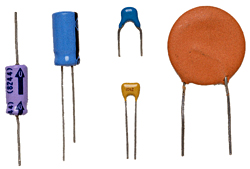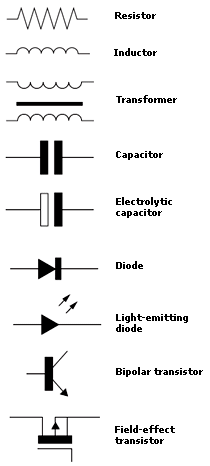DK Science: Electronics
Electronics goes beyond simple electricity. Using the TRANSISTOR and other COMPONENTS, such as resistors and capacitors, electronics allows us to control large electric currents with small electric currents. This opens up a whole new world. Electronics can amplify sound, make radio waves, or handle computer data. OPTOELECTRONICS can use light to work a remote control or send messages across the globe.
In 1947, at the Bell Telephone Laboratories in the USA, John Bardeen (1908–1991, left), Walter Brattain (1902–1987, right), and William Shockley (1910–1989, centre) invented a small, solid device that could amplify electrical signals. They called it a transistor. Until then, the only practical amplifiers were based on fragile glass tubes with a vacuum inside. The team won the Nobel Prize for Physics in 1956.
Electronic circuits are built by fixing components into a plastic board that has copper tracks on one side to link them together. The components are secured and connected by melting a metal called solder around their pins. Modern boards may have several layers of tracks. Some boards contain only part of a circuit. These plug into a mother board, which links several daughter boards to form a complete circuit.
Components are parts from which electronic circuits are built. Each component responds to electricity in a particular way. For example, capacitors block steady currents, while resistors let them through. By connecting up the right components, engineers can build anything from a door chime to a computer.

Capacitors store electric charge. They contain two sets of insulated metal plates and can carry signals between two points without letting direct current through. Electrolytic capacitors hold more charge than other types but they need a steady voltage across them to work.
Resistors control currents and voltages. The current through a resistor is given by the voltage across it divided by its resistance. This means that a resistor can convert a voltage into the corresponding current. On the other hand, if a current is passed through a resistor, it can produce the corresponding voltage.
Electronics engineers use a visual language that gives every component its own symbol. Symbols are linked to show how a circuit is made.
Resistors are made in standard resistance values. These cannot easily be printed on a resistor as numbers, because the resistor’s body is too small. Coloured stripes are used instead. Common resistance values range from 10Ω (10 ohms) to 1MΩ (a million ohms) Fourth stripe
Transistors make modern electronics possible. They allow tiny electric currents to control much bigger currents. This is called amplification. It makes the link between a small signal that says what we want to do and the electrical power that actually does it. The transistors inside a radio, for example, can amplify tiny signals from the aerial to produce loud sounds.

Transistors come in different sizes. The transistors in computer chips are microscopic. Others may be 2.5 cm (1 in) across – big enough to control a motor or deliver high-energy sound. Those shown here (actual size) include a relative of the transistor called the thyristor. Between them, they can handle everything from light bulbs to radio waves.

Current between a transistor’s emitter and collector is normally blocked by the base. But when a small current carrying a signal flows from the emitter to the base, lots of electrons can get through the base to form a much bigger current from the emitter to the collector. The current is a copy of the original signal, so the transistor amplifies it.
Optoelectronics links electronics with light. Its simplest device is the light-dependent resistor (LDR), used in lights that turn on by themselves at night. Light-emitting diodes (LEDs) are used for bike lamps and other signalling jobs, such as controlling a television. DVD players depend on the laser diode, an optoelectronic device that emits the very pure light needed to read the disc.
A light-emitting diode (LED) is a tiny chip of material in a plastic casing. It emits light when current flows through it. The light can be almost any colour, depending on what the diode is made of. Most LEDs contain the rare element gallium. When this is combined with nitrogen and another rare element, indium, it can give blue light. With arsenic and phosphorus it can give red light.
When you change TV channels, an LED in the remote control sends out invisible pulses of infra-red light. These are picked up by a light-sensitive transistor, or phototransistor, at the front of the TV. The pulses are generated by a microchip inside the control. They form a code that tells the television what to do.


